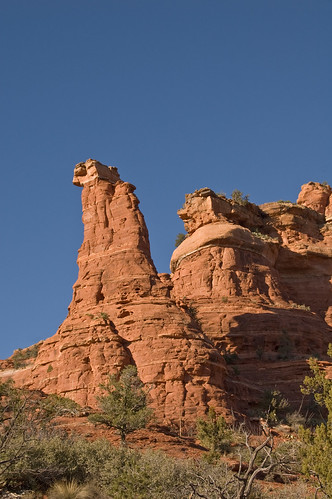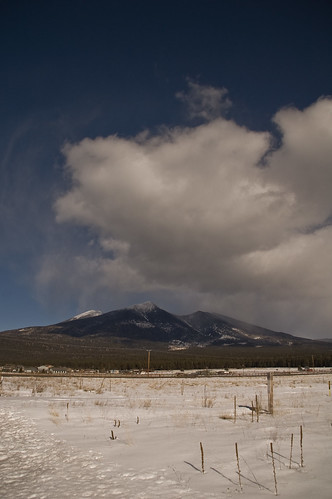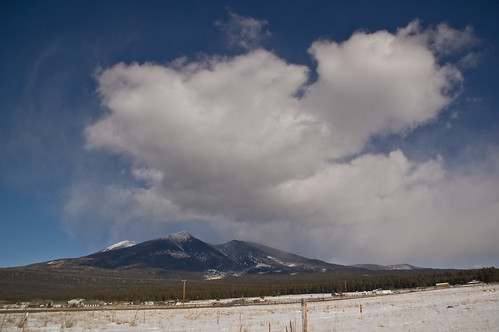Saturday, December 31, 2011
Thursday, December 29, 2011
Sedona Psychic Vortexes
Tourists flock to Sedona, AZ all seasons of the year and we're no different. We recently headed up to Sedona and Flagstaff for a little rest, relaxation, and cross-country skiing.
Though most people visit Sedona for the beautiful and iconic red rock formations that rise from all horizons, the small city also attracts many who adhere to or are curious about the New Age movement. Shops advertising healing crystals, faery and angel stuff, and other New Age and spiritual things line all major roads.
Probably the most iconic metaphysical attractions are several sites around town believed to be vortexes (though the plural of vortex is vortices, in Sedona, they say vortexes). Different people say that vortexes are different things - giant magnets or sites of spiritual energy for example. Some believe they heal, offer mental clarity, or give other-worldly visions. You can even take tours to the vortexes (all of which are pretty easily accessible without a tour; take one of the off-road Jeep tours instead ). Here's a description of the vortexes from the website for one tour group.
To say we're profoundly skeptical of all this would be an understatement, but Erin and I have visited Sedona many times and we've never checked out any of the vortex sites, so we swung by the Kachina Woman Vortex along Boyton Canyon. We found beautiful views, friendly people, and interesting geology, but no angels or faeries or supercharged-spirit-magnet-enlightenment-healing. We did meet a lady who claimed the vortex healed her knee, though, and she recommended the book pictured below. To each her own.

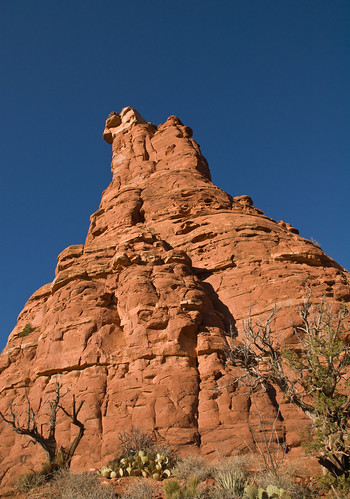
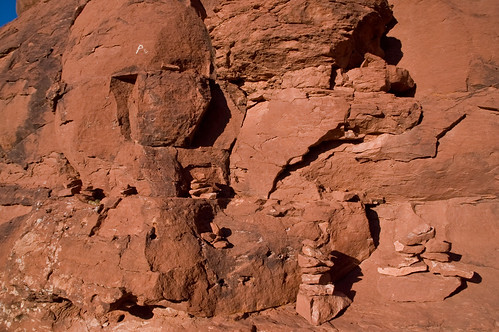
People built small cairns around the vortex site.
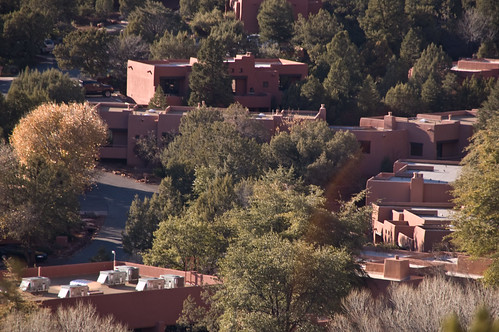
Kachina Woman Vortex overlooks Boyton Canyon. Not sure how a developer got the permit to drop this shitty resort in the middle the canyon...
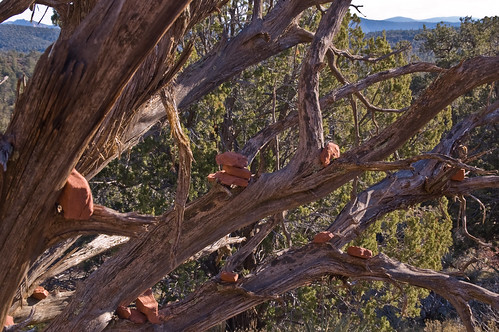

Though most people visit Sedona for the beautiful and iconic red rock formations that rise from all horizons, the small city also attracts many who adhere to or are curious about the New Age movement. Shops advertising healing crystals, faery and angel stuff, and other New Age and spiritual things line all major roads.
Probably the most iconic metaphysical attractions are several sites around town believed to be vortexes (though the plural of vortex is vortices, in Sedona, they say vortexes). Different people say that vortexes are different things - giant magnets or sites of spiritual energy for example. Some believe they heal, offer mental clarity, or give other-worldly visions. You can even take tours to the vortexes (all of which are pretty easily accessible without a tour; take one of the off-road Jeep tours instead ). Here's a description of the vortexes from the website for one tour group.
To say we're profoundly skeptical of all this would be an understatement, but Erin and I have visited Sedona many times and we've never checked out any of the vortex sites, so we swung by the Kachina Woman Vortex along Boyton Canyon. We found beautiful views, friendly people, and interesting geology, but no angels or faeries or supercharged-spirit-magnet-enlightenment-healing. We did meet a lady who claimed the vortex healed her knee, though, and she recommended the book pictured below. To each her own.



People built small cairns around the vortex site.

Kachina Woman Vortex overlooks Boyton Canyon. Not sure how a developer got the permit to drop this shitty resort in the middle the canyon...



Saturday, December 24, 2011
Monday, December 19, 2011
Desert Gothic
The clouds have been thick around the Catalina Mountains every morning this week. Today was the first chance I had to try to take some pictures, so I went to Catalina State Park up in Oro Valley. Not sure my busted old camera can handle difficult light anymore, but a few shots sort of caught the feeling of the cold, wet morning at the foot of the mountains.
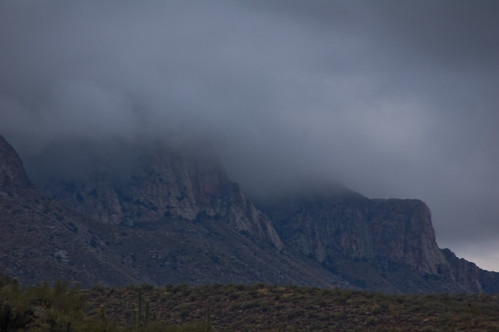



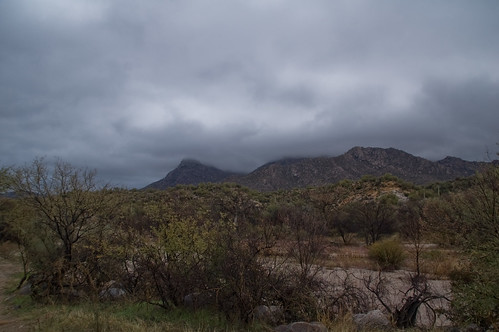
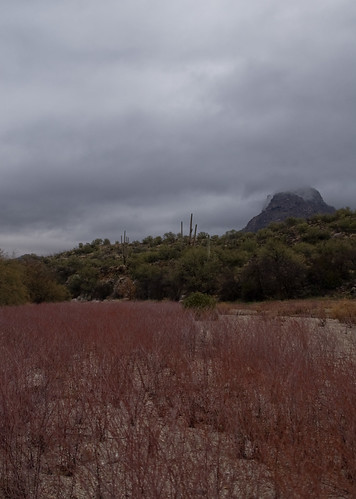

Saturday, December 17, 2011
One Very Important Thought
I read a lot of great quality writing on blogs. User-driven communities online connect disparate people, creating common spaces for the consolidation of ideas and art around mutual interests. The blogrolls where we link to several, or many, other blogs spread out as we link to new blogs and interesting websites; they also reconnect inward as we inter-link to one another's blogs. We form an ever growing, ever solidifying body of writing and art around topics like outdoor pursuits, photography, music and more. And as we span out and interconnect, scores of others on the Internet are doing the same thing around other topics, interests, hobbies, professions, beliefs, and more. Just as the printing press shrunk our ancestors' world half a millennium ago by bringing together literate people, the Internet allows us to construct world-wide imagined communities, enriching our lives through the flow of fascinating information and conversations with one another.
It's important to understand that what we do - the harmless building of communities around common interests - is being threatened now in the United States. The introduction of a bill known as SOPA - or Stop Online Piracy Act - is currently under review by the U.S. House Judiciary Committee. The Wikipedia page seems up to date and explains SOPA and the controversy well. Under the provisions of this bill, sites that publish copyrighted information are liable to be shut down and those who published copyrighted material punished as felons. While the intent to stop online piracy sounds like a logical thing to support, this act is written in a nebulous and open-ended manner that, depending on how it is interpreted, could make sites like Youtube, Google, and others unusable. Google has come out against SOPA. The companies that host our various blogs could also find themselves facing problems under SOPA and our pastimes and communities could vanish while they're still forming. If the Internet is to continue to revolutionize the size, scope, and nature of what we call communities, it must remain free. Copyright law can easily become censorship with the right (or wrong) interpretation.
The following clever quote from this odd little Boards of Canada track is adapted from the end of a 1982 adult film called "A Brief Affair:"
"If you can be told what you can see or read, then it follows that you can be told what to say or think. Defend your constitutionally protected rights. No one else will do it for you."
How many copyrights am I violating by posting this video and quoting from the dialogue in the song? Could this post be taken down? How many of your posts might contain copyrighted material? Is what we're doing wrong?
Thursday, December 15, 2011
Foggy Morning
I woke up to another morning of dense fog. Fog offers uncommon lighting in the usually bright desert, so I grabbed my camera and shot a few pictures. A humid 39 degrees felt like an old friend to my New England bones.
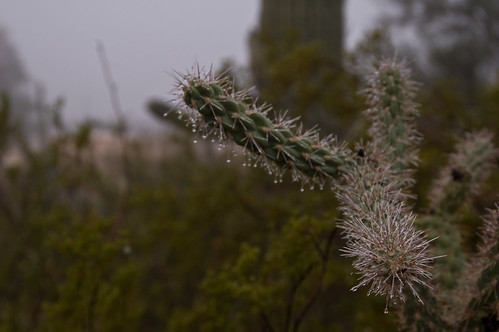

I don't know if these little lacewings were taking shelter in the cholla fruit or eating it. Perhaps edible shelter?

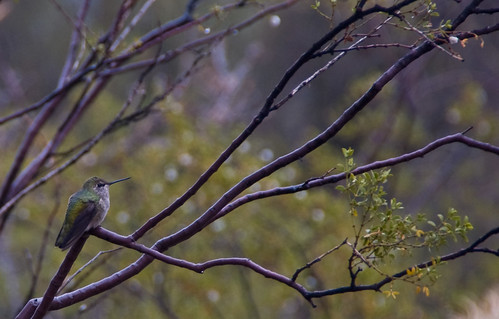
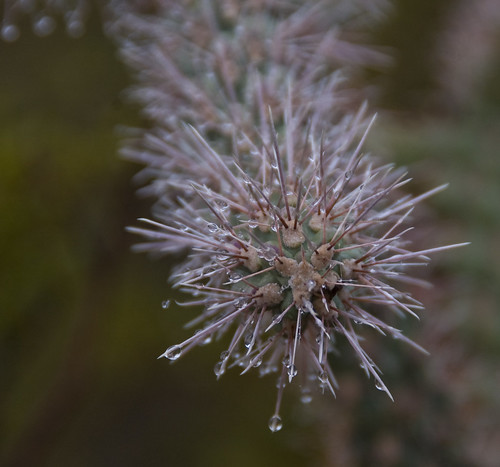



I don't know if these little lacewings were taking shelter in the cholla fruit or eating it. Perhaps edible shelter?




Wednesday, December 14, 2011
Hobo Signs
Found this key to understanding hobo signs while surfing around the Internet. Here's another page dedicated to hobo signs here. Not being a hobo myself, I can't vouch for the accuracy of this list, but I thought it was pretty neat. My favorite is "Kind Lady Lives Here" because the symbol is a cat. I know quite a few kind ladies with cats.
Tuesday, December 13, 2011
Dry Neighbors
Erin spotted this desert tarantula (technically an Arizona Blond Tarantula) huddled on the threshold of our kitchen door this morning. It's been raining and cold here in Tucson for a few days, so his burrow must be pretty inhospitable, possibly flooded. This fellow is probably male or juvenile because it's not a very big tarantula (though still damn big for a spider) and the females are larger than the males.
We don't mind sharing a little heat. Keep warm, buddy.
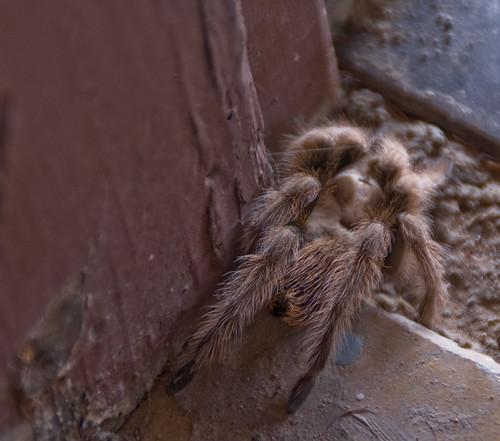

Update: I didn't originally post the following pictures of the tarantula because it was sitting near a pile of packrat turds, which is pretty gross, but upon looking at them again, I noticed that one of those turds is actually not a turd at all, but a regular sized spider. The contrast between the two spiders justifies posting the shots.
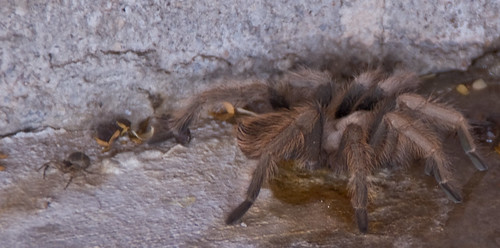
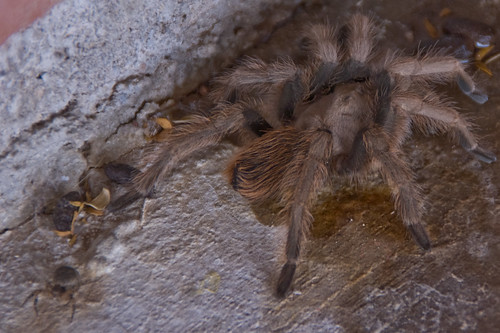
We don't mind sharing a little heat. Keep warm, buddy.


Update: I didn't originally post the following pictures of the tarantula because it was sitting near a pile of packrat turds, which is pretty gross, but upon looking at them again, I noticed that one of those turds is actually not a turd at all, but a regular sized spider. The contrast between the two spiders justifies posting the shots.


Wednesday, December 7, 2011
Whitmansexual
 |
| Walt Whitman |
Whenever I teach or discuss Walt Whitman, conversation always seems to find it's way back to the poet's sexuality (look, it's happening again...). In once sense, discussing Whitman's homosexuality reaffirms what we should all already know - that our heroes, icons, and leaders of previous generations included gay men and women, even if they weren't able to publicly fulfill their romantic and emotional lives. We should celebrate Whitman's sexuality as an integral part of our understanding of the poet, and, by extension, remember to embrace homosexuality as a creative and generative force in American culture. Of course no one is wholly their sexuality, this is true for Whitman as well. As a teacher and student of literature, I've struggled to meaningfully situate Whitman's sexuality in respect to the totality of his writing and his aura. Luckily, Antler found the words and put them together for us in his poem, "Whitmansexual," reproduced below. Be sure to check out more of Antler poetry here on his website.
Whitmansexual
Whitman was a mansexual,
a womansexual,
A grasssexual, a treesexual,
a skysexual, an earthsexual.
Whitman was an oceansexual, a mountainsexual,
a cloudsexual, a prariesexual,
A birdsongsexual, a lilacsmellsexual,
a gallopinghorsesexual.
Whitman was a darknesssexual, a sleepersexual,
a sunrisesexual, a MilkyWaysexual,
A gentlebreezesexual, an openroadsexual,
a wildernesssexual, a democracysexual,
A drumtapssexual, a crossingbrooklynferrysexual,
a sands-at-seventy-sexual.
Whitman was a farewell-my-fancy-sexual,
a luckier-than-was-thought-sexual,
A deathsexual, a corpsewatchsexual,
a compostsexual, a poets-to-come-sexual,
A miracle-sexual, an immortalitysexual,
a cosmos-sexual, a waiting-for-you-sexual.
Whitman was a mansexual,
a womansexual,
A grasssexual, a treesexual,
a skysexual, an earthsexual.
Whitman was an oceansexual, a mountainsexual,
a cloudsexual, a prariesexual,
A birdsongsexual, a lilacsmellsexual,
a gallopinghorsesexual.
Whitman was a darknesssexual, a sleepersexual,
a sunrisesexual, a MilkyWaysexual,
A gentlebreezesexual, an openroadsexual,
a wildernesssexual, a democracysexual,
A drumtapssexual, a crossingbrooklynferrysexual,
a sands-at-seventy-sexual.
Whitman was a farewell-my-fancy-sexual,
a luckier-than-was-thought-sexual,
A deathsexual, a corpsewatchsexual,
a compostsexual, a poets-to-come-sexual,
A miracle-sexual, an immortalitysexual,
a cosmos-sexual, a waiting-for-you-sexual.
Thursday, December 1, 2011
Pururambo
Erin and I watched Pavol Barabas's exploration documentary, Pururambo, and I can't say I'm entirely positive how I feel about it. I've been a delinquent blogger (but perhaps a better grad student) and I thought this movie might be something interesting enough to share.
Barabas is a Slovak film maker and explorer; Pururambo documents his trip into the interior of New Guinea and his various encounters with distinct groups of Kombai native people. I tried to find an English version on Youtube, but no luck. We watched it on Netflix and it's available for streaming.
Barabas travels through thick jungle swamps, encountering wary people, and establishing goodwill with packets of tobacco and sugar candy. He stops with each encounter to highlight something about the group he's with, reveal larger aspects of Kombai life, or pontificate on the deleterious effects of Western cultures on indigenous peoples. Barabas is particularly tough on missionaries for corrupting and destroying cultures, even dedicating the final, frustrating moments of the film to the Kombai's hypothetical cultural death after exposure to missionaries. Of course, his criticisms stand - missionaries wreak havoc on indigenous cultures, inculcating them with ideologies and rules they are not culturally prepared to understand. All the antibiotics and Salvation Army jean shorts in the world can't buy a culture. The result is infrequently conversion to Christianity, but often the loss of the original culture. Yet, as Barabas strolls into villages, quelling arrows and gaining shelter, food, and guidance before a camera lens, one has to wonder whether some of the vitriol he aims at missionaries isn't on some level to ameliorate his own conscience. His presence disrupts each village he enters and he offers gifts of food and reveals technology. More often than not he narrowly escapes being shot by obviously alarmed and bewildered men before gaining confidence and hospitality. If you're a Star Trek nerd, you might say he violates the Prime Directive.
Keeping in mind that the film is translated from Slovak, Barabas's word choice might not quite meet professional anthropological standards. He refers to the Kombai as "barbaric" and "headhunters." I admire how he presents his discomfort and even fear, but at times I felt unguided when trying to determine if he described the Kombai or his own anxiety about them with this language, and I think that distinction matters.
Finally, the film ends abruptly with no explanations. The Internet furnishes no clues, so prepare to be frustrated. That sounds like a lot of criticism, but of course some of it is my attempts to reconcile what it means to be of Barabas's tribe and consider he represents us to the Kombai, whether he intends to or not. With all my ethical reservations, the footage is remarkable and it certainly raises awareness. The film exists to be seen now and even a 55 minute glimpse of a culture so vastly different than ours deserves seeing. At minute 6:50 in the clip I provided, a man explains how they count using places on their bodies rather than with their fingers.
Subscribe to:
Posts (Atom)


